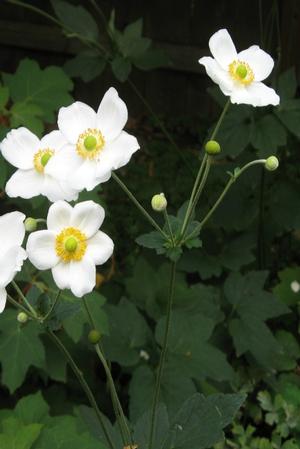
Anemone × hybrida 'Honorine Jobert'
Japanese windflower
 |
PPA Perennial of the Year 2016 |
 |
RHS Award of Garden Merit in 1993 |
 |
Discovered by Messier Jobert in Verdun, France in 1858 and named after his daughter Honorine |
 |
Once established, naturalizes an area quickly through rhizomatous colonies |
This stately, clear-white Anemone selection was made in the mid-1800's and is still beloved by the modern gardener. Perhaps it is the charm of its unique flowers and preblooms in late summer or the joy of watching its easy sway in the late summer breeze. Ultimately, we love it because it is an effortless and reliable presence in the garden. Whatever the reason that you fall in love with 'Honorine Jobert' know that it is a timeless classic.
| SIZE | |
|---|---|
| Anemone 'Honorine Jobert' - 50 per flat | Availability |
Height3-4 Feet |
Spread2-3 Feet |
Spacing18 Inches |
Bloom ColorWhite |
USDA Hardiness Zone 5-8 |
Japanese windflower Interesting Notes
The Perennial Plant Association's 2016 Perennial Plant of the Year®
The event of the windflower, especially A. 'Honorine Jobert' has delighted gardeners for over 200 years.
In mid-spring, it presents its sharply pointed foliage in rich colonies of mounded foliage. Through-out the spring and summer season it wants for nothing so far as maintenance when grown in part to full shade. Then, by mid-summer, the suspended pre-blooms appear above long, dark olive stems jutting through the lush mounds. The blooms burst from the ends of the wirey stems where the paper-light flowers move effortlessly in the slightlest breeze. The show doesn't end there. The spent blooms give way to an extraordinary seed head that appears as a ball of cotton on the end of the stem which holds all through the winter if left untouched.
Anemone × hybrida 'Honorine Jobert' Growing and Maintenance Tips
Morning sun and filtered afternoon light combined with a fertile, moist, humus rich soil is the best environment. Japanese anemone does poorly in summer drought, exposed and windy sites, and wet winter soils. If the first conditions are fulfilled the spread of Japanese anemone is reasonably fast. A winter mulch is beneficial in northern climates. Propagate by division in spring or root cuttings. - Steven Still, Manual of Herbaceous Ornamental Plants
Key Characteristics & Attributes



Additional Information
|
Soil Moisture Needs
|
Plug Type
|
Season of Interest (Flowering)
|







